In golf, the only connection a player has with the golf club is the grip. Without the grip, none of us are even playing the game.
Having the proper golf grip is essential, and its a part of the game that every player needs to master.
In this guide, we have put together the steps to master the golf grip.
Types of Golf Grips
Before you can master your perfect golf grip, you must make sure that you choose the type of grip that works best for your body type.
There are three main types of grips in golf.
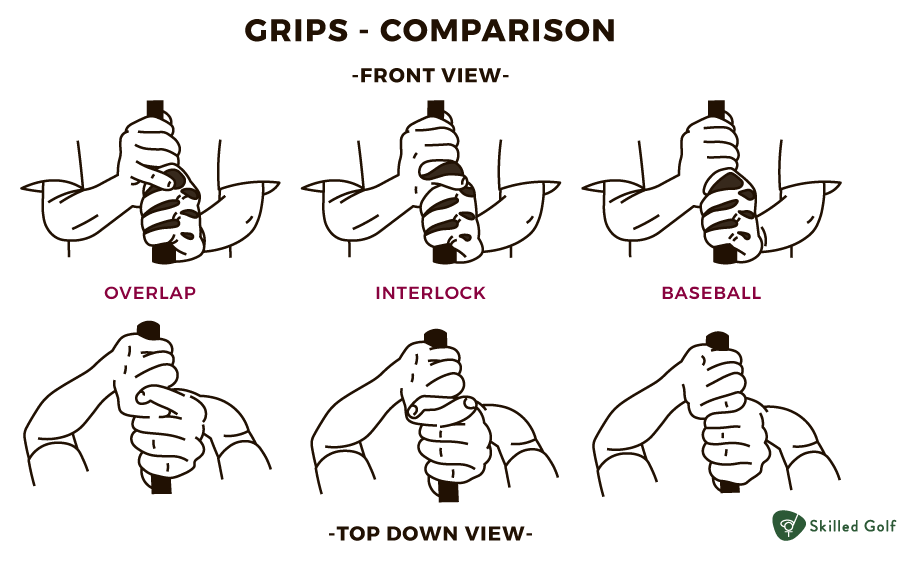
The tree grips are very similar, except for one key factor.
Depending on what type of grip you choose, your index finger on your left hand and your pinky on your right hand will have varying positions.
You will have to experiment with the different types of golf grips to find one that works the best golf grips for your hands and your golf game.
Traditionally speaking, golfers with smaller hands will do better with the interlocking grips, and those with larger hands do better with the overlapping golf grip.
Step By Step Guide To The Proper Golf Grip
The steps of placing your hand on a golf club- for a right handed golfer
Step One: Left Hand Position
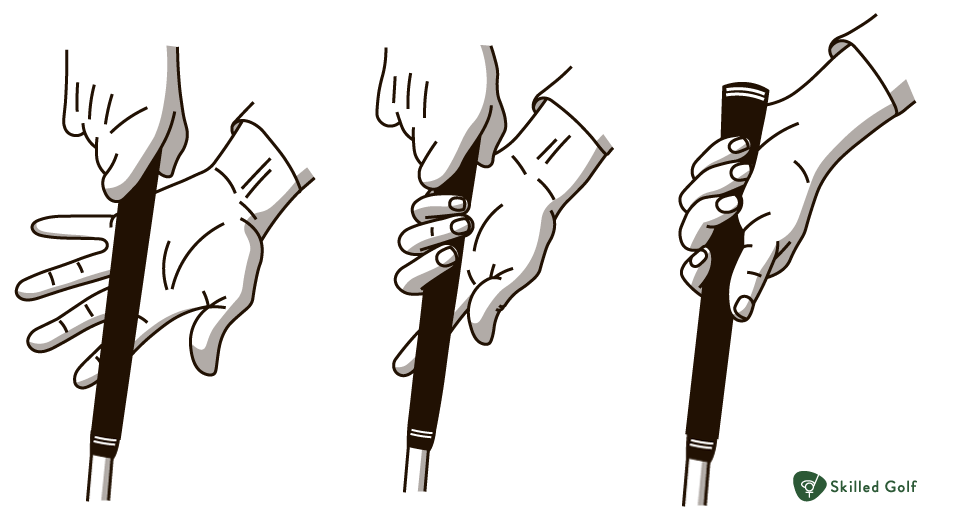
When you first get your hands on the club, you must make sure that you get your left in the proper position.
The golf club must sit in the fingers of your left hand. When you hold your left hand out, lay the club across your fingers and slightly into the palm.
Many golfers get the club too far into the palm of the hand, and this will lead to poor fundamentals when you start swinging the golf club.
The index finger and the thumb of your left hand will create a letter “V.” This V will need to point to your right shoulder.
This is how you know your left hand is on the club properly. When you feel that the left hand is on the grip in the correct location, you can move to the right hand.
Step Two: Right-Hand Position
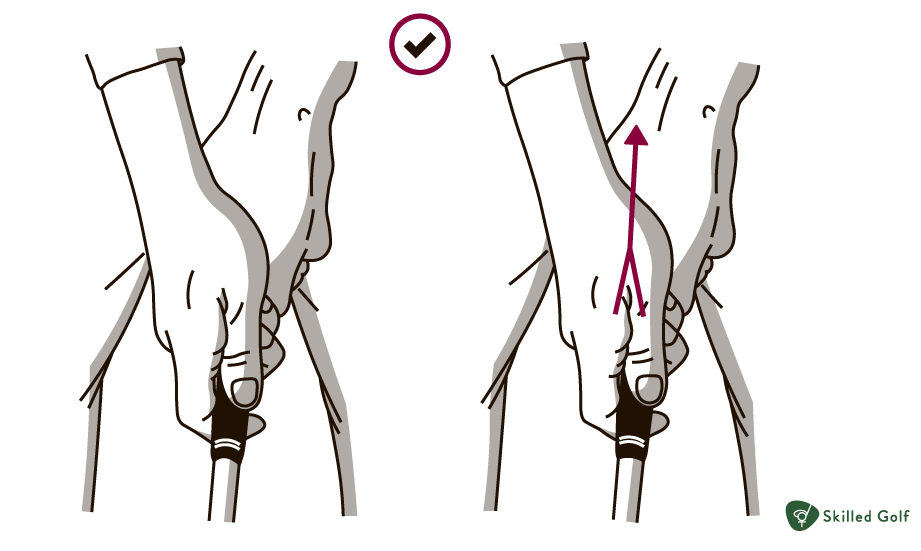
When you place the right hand on the golf club, you will need to decide if you will try a ten-finger, overlap, or interlocking grip. You may have to grip the club with all three to see what makes the most sense for your game.
The right-handed player will take their right hand and cover the left thumb. The left thumb should fit perfectly in the palm of the right hand. If this is done correctly, the fingers on the right hand will hold the golf club’s grip, and it won’t be sitting in the palm of the hand.
You will want to make sure that both your left and right hand grip the golf club using mostly the fingers. If you let the club get into the palm, it makes the hands get too involved with the golf swing.
Step Three: The Thumb
Now that both hands are on the club, you may be wondering what you are supposed to do with the thumb of your right hand. The thumb should point just to the left of the center on the golf grip.
You do not want to wrap your thumb entirely around the grip, as it will change how your fingers are sitting on the club. If you point your right thumb straight down the shaft, you may not have enough control over the golf club.
Another thing to mention about both of the thumbs is how far to extend them. For a perfect golf grip, you will want your thumbs to sit naturally on the golf club. If you have them outstretched too far or pushed in too much, it will have some significant impacts on your golf club swing plane and potentially on your grip pressure as well.
Step Four: Grip Pressure
Knowing the perfect grip pressure can be a bit difficult, especially for a new golfer.
For the most part, you should feel like you have just enough pressure that you are not going to throw the club. The lighter golf grip will make it easier to get the club in the correct positions in your golf swing.
If you are gripping the club too hard, it makes it much harder to release the club. Releasing happens as you come through the impact position, and you turn the clubface from open to square to eventually closed.
It can take a while to learn how to release a golf club, but it will take even longer if you are gripping the club to death. The more confident you get in the proper grip for golf, the better your pressure will be.
Golfers who have been playing for many years know how to grip the club with enough pressure not to impact the swing.
Step Five: Grip Size

One of the factors in ensuring you have the proper grip on your golf club is making sure the grip itself is the right size for you.
Many players don’t know that there are lots of different grip sizes. If you have a smaller or larger hand than the standard, you may need to have the grips on your clubs changed.
If you talk to a local golf professional, they will be able to measure your hand size and make sure you have a proper golf grip for your hand size.
If you are wearing an extra-large glove and playing with a standard grip, chances are it is causing some issues with your hand position and your golf game as well.
Women and juniors should always play with undersized golf grips. Their hands are generally quite a bit smaller, and the men’s standard grips tend to make it hard to release the club and hit the ball straight.
Differences In Grips Between Clubs
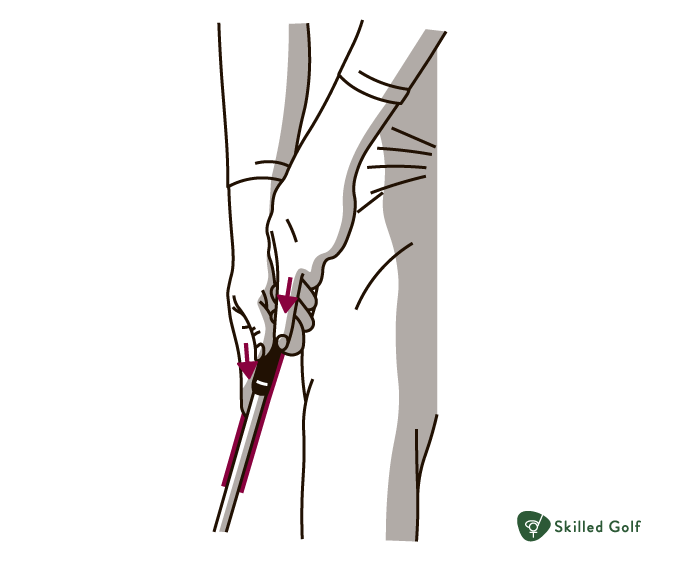
For the most part, you will want your golf grip to remain the same anytime you grip a club. It does not matter if it is your wedge or your driver; your golf grip should be the same.
The grip in golf only changes when you switch to the putter.
Changing your golf grip when putting is mandatory, but it is something that many golfers tend to do. Since you do not need to swing the club back with the putter, you can be more creative about how you grip the club.
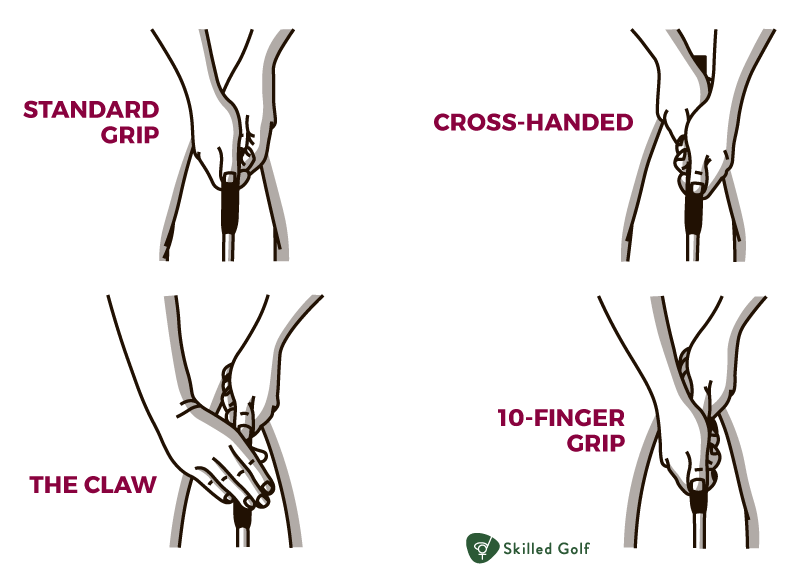
There are four common ways to grip a putter. They are the standard, cross-handed, claw, and ten-finger. The ten-finger grip will be the same as a traditional ten-finger grip, but many players will point their right thumb straight down the shaft.
The cross-handed grip for putting can be very effective in helping people stabilize their hands while putting. Some players tend to flip their wrists as they come through the golf ball; this leads to an inconsistent putting stroke.
When you place your hands on the golf club cross-handed, it helps to eliminate some of the flipping and keep the putting stroke more consistent.
Common Mistakes and How To Avoid Them
Weak and Strong
The most common golf grip mistakes are gripping the club too weakly or too strongly.
If your grip is too strong your right hand will be too far underneath the golf club. If your grip is too weak, your right hand will be too far over the golf club’s top. These are usually simple fixes.
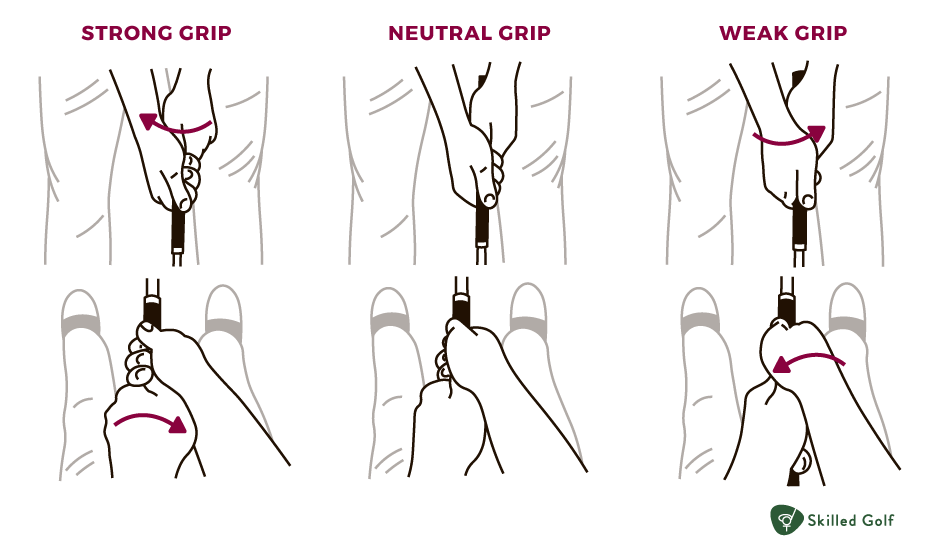
When you find out that your grip is too weak or too strong, you may want to check to see if your left hand is in the right position.
Although this issue looks like it is only related to the right hand, sometimes the left hand is not allowing the right hand to get into the proper golf grip position.
If you are unsure if your grip is correctly placed on the club, you will want to grip it in a mirror. When you look at how your hands are in a mirror, you should be able to see if everything is in the right place, and your grip is neutral.
Club in Palm of Hand
Another common mistake is gripping the club too much in the palm. If that V made by the thumb and index finger of your left hand is not pointed at your right shoulder, then chances are that the club is not in your fingers and is in the palm.
Hitting golf shots with too much of the club in the palm of your hand will result in improper release and the club potentially getting off plane as well.
The only real way to fix this issue is to continually check your grip and make sure it sits in the fingers of your hands.
Left Handed vs Right Handed Golfer
A left handed golfer will reverse the steps that a right handed golfer takes. When a right hander puts their left hand on the golf club, a left hander will put their right hand.
The same goes when it is time to put the second hand on the golf club. The Left hander puts their left hand on last.
Left handers still need to keep the grip in the fingers of their hands and make sure that the grip pressure is as light as possible.
Conclusion
Did our guide on the proper golf grip help you see some of the issues that you may be having in your game?
Amateur golfers don’t give the grip enough credit. Without the golf grip, there is no golf!
Next time you haphazardly place your hands on the golf club, try and remember what we said about your only connection to the club coming from your hands.

